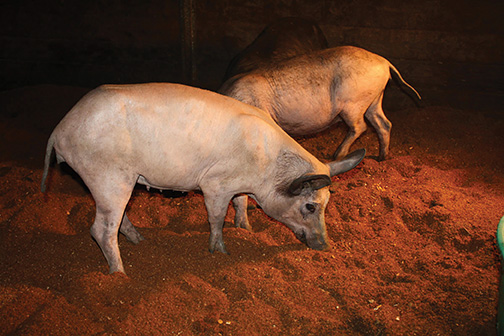Running for a Cause: How Putting Yucatan Miniature Pigs on Treadmills Helps Fight Heart Disease
If you walk by Dr. Cristine Heaps’ lab on a sunny afternoon in the spring, you may see Yucatán miniature pigs running on treadmills.
 Heaps, an associate professor in the Department of Veterinary Physiology & Pharmacology at the Texas A&M College of Veterinary Medicine & Biomedical Sciences (CVM), studies the effects of exercise on heart disease using these pigs. Adaptations in the heart during exercise intrigued Heaps, who was involved in athletics from a young age.
Heaps, an associate professor in the Department of Veterinary Physiology & Pharmacology at the Texas A&M College of Veterinary Medicine & Biomedical Sciences (CVM), studies the effects of exercise on heart disease using these pigs. Adaptations in the heart during exercise intrigued Heaps, who was involved in athletics from a young age.
Exercise puts demands on a body, causing the heart to beat faster and move blood more quickly through the cardiovascular system. A person with heart disease may be fine while watching a rerun of Survivor; however, after the show is over and the person is sweating like a pig while pushing a lawn mower, he may suddenly have a heart attack.
Risk factors, such as obesity and lack of physical activity, contribute to the development of cardiovascular disease. According to the 2013 Overweight and Obesity Update by the Centers for Disease Control and Prevention, around 50% (154.7 million) of Americans 20 years and older are overweight. As obesity rates increase in other countries, the number of deaths caused by cardiovascular disease will also rise.
So why use pigs in research? A pig’s cardiovascular system functions similarly to a human’s. Likewise, the pig body mimics a human’s in response to exercise; therefore, running pigs with heart disease on treadmills models humans with heart disease exercising.
Arranging for approximately 100-pound Yucatán miniature pigs to run on a treadmill you might see at a local gym is both labor-intensive and expensive, so this type of model is uncommon. In fact, Heaps’ lab is one of the few in the United States using a pig model combining heart disease and exercise.
Researchers elsewhere contact her to collaborate. Dr. Steven Fisher, a physician and recent collaborator from the University of Maryland’s School of Medicine, contacted Heaps to help with his research because she uses this model. “Very few labs have this model,” Fisher said. “Coronary heart disease is very difficult to model.” A recent study by Heaps and Fisher indicates exercise may increase the heart’s sensitivity to drugs such as Viagra. In addition to her recent collaboration with Fisher, Heaps also works with faculty at both the CVM and the Texas A&M Health Science Center.
Often waiting in silence, cardiovascular disease is deadly until conditions are right, such as exacerbation by exercise. This disease has not only severe, often fatal, health implications but economic repercussions as well. Heaps noted, “Billions to hundreds of billions of dollars and productivity are lost to heart disease.”



